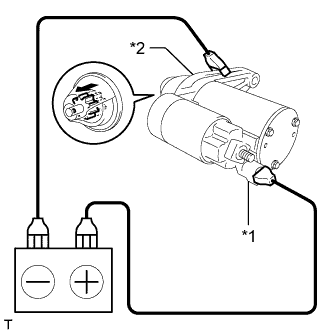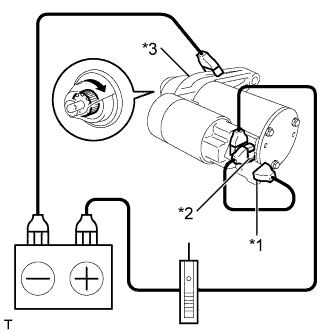Starter (For Hatchback Except Cold Area Specification Vehicles) -- Inspection |
| 1. INSPECT STARTER ASSEMBLY |
- NOTICE:
- The following tests must be performed within 5 seconds to prevent the coil from burning out.
Perform a pull-in test.
Connect the battery to the magnet starter switch assembly as shown in the illustration. Check that the clutch pinion gear is extended.
If the clutch pinion gear does not move, replace the magnet starter switch assembly.Text in Illustration *1 Terminal 50 *2 Body

Inspect the clutch pinion gear return.
Disconnect the negative (-) lead from the starter body. Check that the clutch pinion gear returns.
If the clutch pinion gear does not return inward, replace the magnet starter switch assembly.Text in Illustration *1 Terminal 50 *2 Body
 |
Perform a no-load performance test.
Clamp the starter in a vise.
- NOTICE:
- Do not clamp the vise too tightly.
Connect the battery and an ammeter to the starter as shown in the illustration.
Text in Illustration *1 Terminal 50 *2 Terminal 30 *3 Body Check that the starter rotates smoothly and steadily with the clutch pinion gear extended.
Measure the current according to the value(s) in the table below.- Standard Current:
Tester Connection Condition Specified Condition Battery positive terminal - Terminal 30 - Terminal 50 11.5 V Below 90 A

| 2. INSPECT STARTER ARMATURE ASSEMBLY |
Check the commutator for an open circuit.
Measure the resistance according to the value(s) in the table below.
- Standard Resistance:
Tester Connection Condition Specified Condition Segment - Segment Always Below 1 Ω
Text in Illustration *1 Segment

Check the commutator for a short to ground.
Measure the resistance according to the value(s) in the table below.
- Standard Resistance:
Tester Connection Condition Specified Condition Segment - Coil Core Always 10 kΩ or higher
Text in Illustration *1 Segment *2 Coil Core

Check the commutator surface for dirt and burns.
If the surface is dirty or burnt, restore it with sandpaper (No. 400) or a lathe.
Check the commutator for circle runout.
Place the commutator on V-blocks.
Using a dial indicator, measure the circle runout.
- Maximum runout:
- 0.05 mm (0.00197 in.)
- Maximum runout:
- 0.05 mm (0.00197 in.)

Using a vernier caliper, measure the commutator diameter.
- Standard diameter:
- 25.0 mm (0.9843 in.)
- Minimum diameter:
- 24.0 mm (0.9449 in.)
 |
Check that the undercut portion between the segments is free of foreign matter and measure its depth.
- Standard undercut depth:
- 0.7 mm (0.0276 in.)
- Minimum undercut depth:
- 0.2 mm (0.0079 in.)
 |
| 3. INSPECT STARTER BRUSH HOLDER ASSEMBLY |
Using a vernier caliper, measure the brush length.
- Standard length:
- 11.6 mm (0.4567 in.)
- Minimum length:
- 7.6 mm (0.2992 in.)
 |
| 4. INSPECT STARTER CLUTCH SUB-ASSEMBLY |
Hold the starter clutch sub-assembly, rotate the pinion gear clockwise, and check that it turns freely. Try to rotate the pinion gear counterclockwise and check that it locks.
If necessary, replace the starter clutch sub-assembly.Text in Illustration *a Free *b Lock
 |
| 5. INSPECT MAGNET STARTER SWITCH ASSEMBLY |
Check the plunger.
Push in the plunger and check that it returns quickly to its original position.
If necessary, replace the magnet starter switch assembly.Text in Illustration *1 Plunger

Check the holding coil for an open circuit.
Measure the resistance according to the value(s) in the table below.
- Standard Resistance:
Tester Connection Condition Specified Condition Terminal 50 - Body Always Below 2 Ω
Text in Illustration *1 Terminal 50 *2 Body
